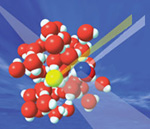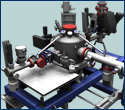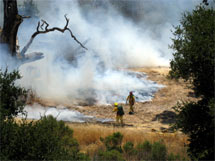Using SSRL's beam line 5-4, researchers from Fudan University in Shanghai and
SSRL have worked out the mechanism behind the formation of charge density waves
in 2H-structured transition metal dichalcogenides (2H-TMD's). The results were
published in the November 21, 2007 edition of Physical Review Letters.
Charge density waves (CDWs) are quantum mechanical ordering phenomena akin to
superconductivity. In a normal conductive metal, electrons persist in a "sea"
wherein they are evenly distributed and the ions form a perfectly periodic
lattice. A charge density wave occurs under certain circumstances - such as in
low dimensional materials - that cause the electrons and ions to couple
together to lower their energy. A modulation of the ions' positions and
"waves" in the electron sea are observed, creating new periodicities that
hinder the conducting electrons, thus lowering the compound's conductivity.
Understanding CDW formation is an important step in characterizing the
fundamental electronic properties of matter. The mechanism behind CDW formation
is typically ascribed to Fermi surface nesting, a phenomenon wherein a
material's electrons correlate with each other on the basis of their momentum
and energy. However, CDW formation in 2H-TMD's appears to arise through a
different mechanism. Using angle resolved photoemission spectroscopy (ARPES),
the Fudan and SSRL researchers have for the first time characterized this new
mechanism.
To learn more about this research see the full scientific highlight at:
http://www-ssrl.slac.stanford.edu/research/highlights_archive/cdw-mechanism.html
2. Science Highlight —
More Evidence for a Revolutionary Theory of Water
(contact: A. Nilsson, nilsson@slac.stanford.edu)
 | |
| Recent X-ray spectroscopy studies have revealed that modern theories of
the structure of liquid water are incorrect.
| |
The traditional picture of how liquid water behaves on a molecular level is
wrong, according to new experimental evidence collected by a collaboration of
researchers from the Department of Energy's Stanford Linear Accelerator Center
(SLAC) in California, RIKEN SPring-8 synchrotron and Hiroshima University in
Japan and Stockholm University in Sweden. The team, involving SLAC scientist
Anders Nilsson, used advanced X-ray spectroscopy techniques to create a more
detailed picture of water's molecular behavior. The results are published as
the cover story in the July 30, 2008 edition of the journal
Chemical Physics Letters.
Water, by any measure, is rather unique. It behaves unlike any other liquid. It
has a tremendous capacity for carrying heat. Its solid phase-ice-is less dense
than the liquid. Water also has unusually strong surface tension. These unusual
properties are what make water such an essential substance to the existence of
life.
In the recent study, Nilsson and colleagues probed the structure of liquid
water using X-ray Emission Spectroscopy and X-ray Absorption Spectroscopy. In
partial agreement with the traditional model, Nilsson's team found that liquid
water is in part made up of tetrahedral groups of molecules. But clear evidence
also emerged for the dominance of a second, less defined structure in the mix.
Settling the debate about water's molecular structure holds tremendous
importance for a range of fields including medicine, chemistry and biology.
Current molecular dynamics models, which are used to understand chemical and
biological processes, are notoriously limited in their ability to predict
water's behavior.
See also: http://home.slac.stanford.edu/pressreleases/2008/20080630.htm
3.
Call for Award Nominations
Please take a few moments to consider nominating your colleagues or students
for one or more of the following awards which will be presented at the Joint
SSRL and LCLS Users' Meeting, October 15-18, 2008.
http://www-conf.slac.stanford.edu/ssrl-lcls/2008/
William E. Spicer Young Investigator Award - Nominations due August 1.
The Spicer Award is open to senior graduate students and those within seven
years of entry into their professional scientific field. The awardee receives
$1,000 and a certificate. The nomination package should include a letter of
nomination as well as the candidate's curriculum vitae and publications;
supporting letters are encouraged.
http://www-conf.slac.stanford.edu/ssrl-lcls/2008/youngInvestigatorAward.asp
Melvin P. Klein Professional Development Award - Nominations due August
1.
The Klein Award consists of $1,000 to be given to a graduate or
undergraduate
student to disseminate scientific results based on work performed at SSRL (to
support the presentation of this work at a scientific conference). The
nomination package should include a letter of recommendation from the advisor;
a brief abstract written by the candidate describing the experiment and
scientific results; and information on when and where the work is to be
presented. http://www-conf.slac.stanford.edu/ssrl-lcls/2008/scientificDevelopmentAward.asp
Farrel W. Lytle Award - Nominations due August 15.
The Lytle Award recognizes important technical or scientific accomplishments
in synchrotron radiation-based science and efforts to foster collaboration and
efficient use of beam time at SSRL. The awardee receives $1,000 and a
certificate (awardee names are added to a plaque displayed in the SSRL User
Research Administration Office).
http://www-conf.slac.stanford.edu/ssrl-lcls/2008/FarrelWLytleAward.asp
4.
User Research Administration Update
(contact: C. Knotts, knotts@slac.stanford.edu)
New Web Interface for X-ray/VUV Beam Time Requests - Due September 5
If you are interested in requesting beam time on X-ray/VUV beam lines
(http://www-ssrl.slac.stanford.edu/beamlines/) for the first scheduling period
for the 2008-09 run (~mid November-early February), please submit your request
by September 5. To assist you in keeping track of your active proposals and to
facilitate submitting your beam time requests electronically, we have developed
(and are very pleased to announce) a new web interface for SSRL User Research
Administration (URA). Just log in to the URA website
https://www-ssrl.slac.stanford.edu/URAWI/Login.html to register,
request a password, update your personal information, view a list of your
active proposals, and submit your X-ray/VUV beam time request. Additional
features will be added the URA system later to facilitate crystallography beam
time requests, scheduling, user support, and submitting new proposals. We
welcome your feedback as we continue to develop these mechanisms.
2008-09 SPEAR Operating Schedule Posted
The current user run will end at 6 am on August 11 which means we are already
looking forward to the next user run which is scheduled to resume in early
November. The draft schedule for the 2008-09 run is available at
http://www-ssrl.slac.stanford.edu/schedules/08-09_run.pdf
SSRL Appreciates Your Feedback
If you have already returned an End of Run Summary form for your beam time at
SSRL during the 2008 run, thank you! If you have not yet done so, please submit
an End of Run Summary at your earliest convenience (we need your feedback after
each experiment is conducted, even if multiple beam lines or proposals). Your
comments and suggestions are very important to us. This information is used in
various DOE reports and it also helps us to continually improve our user
services. You can either pick up a copy of this from while you are at SSRL or
complete the on-line survey at: http://www-ssrl.slac.stanford.edu/users/user_admin/form_ers.html
Thank you for taking the time to provide your feedback on the End of Run
Summary!
5.
Mini-Shutdown Used for Top-off Prep Work
(contact: R. Hettel, hettel@slac.stanford.edu)
SSRL concluded the budget driven 2-week shutdown in July during which several
activities related to future top-off injection were completed. The most
significant accomplishment was the 10-day modification of the personnel
protection system to allow top-off operation. Beam containment interlock
components and related cabling for several magnet power supplies were also
installed. Preparatory work was done for the upcoming installation of electron
clearing magnets required for top-off injection for dipole beam lines.
Finally, an air ventilation system was commissioned to help cool the injector
booster synchrotron, which will operate more frequently in the top-off
injection era. Related to improving SPEAR3 operational reliability, work was
done to improve the cooling water flow rate control components to eliminate
spurious low-flow interlock trips that have been experienced in the past.
6.
Register for SSRL/LCLS 2008
Register now for the Joint SSRL/LCLS Users' Meeting and Workshops which will be
held here at SLAC October 15-18, 2008. Plan to share your recent research
results during the user science poster session. This annual event is a valuable
opportunity to learn about the latest plans, new developments and exciting user
research at SSRL and LCLS. It is also a great time to interact with other
scientists, potential colleagues, staff and vendors of light source-related
products and services.
http://www-conf.slac.stanford.edu/ssrl-lcls/2008/
LCLS/SSRL 2008 will begin on October 15 with presentations related to LCLS
Science and Instrumentation, LCLS user access policies, updates on LCLS user
operations, and a meeting of the LCLS user community. SSRL workshop options
will be held concurrently on this day, including: Crystallography Made Easy
through Automation, and Advanced Topics in EXAFS Analysis and Applications.
The joint LCLS/SSRL session on October 16 will feature a keynote presentation
by SLAC Director Persis Drell on the Future of Photon Science at SLAC, updates
from SLAC and DOE, user science highlights, and the user science poster
session. The Spicer Young Investigator Award, Klein Professional Development
Award, and Lytle Award will be presented on this day.
SSRL sessions on Structural Molecular Biology, Materials and Environmental
Sciences, and facility updates continue on October 17, to be followed by a
meeting of the SSRL Users' Organization.
LCLS-related workshops will be held October 17-18: Application of Coherent
X-rays at the LCLS, Atomic, Molecular & Optical Physics with the LCLS, and Soft
X-ray Instrumentation for LCLS.
Please help us to publicize the annual conference by posting the conference
poster in your work areas. http://www-conf.slac.stanford.edu/ssrl-lcls/2008/lclsssrl08_poster1.pdf
7.
Future Opportunities with PEP-X
Although SPEAR3 will remain a forefront third generation synchrotron light
sources for years to come, SSRL is making plans for a longer-term future. The
physical size (circumference) of SPEAR3 constitutes a barrier to upgrading it
to achieve significantly higher brightness, which is required for the study of
complex materials on the nanoscale, in combination with time and energy
resolved measurements. Therefore the future plans for SSRL could involve the
transfer of the scientific programs from SPEAR3 to a higher-performing x-ray
source, PEP-X. PEP-X is based on the development of an existing large storage
ring (2.2 km circumference) on the SLAC site, PEP-II, into an x-ray source
which produces x-rays with an average brightness that exceeds any other storage
ring light source, existing or planned, by more than a factor of 10, and SPEAR3
by more than a factor of 1000. A study group is exploring the PEP-X
opportunities, and their report, PEP-X Light Source at SLAC, is available for
your review. http://www-ssrl.slac.stanford.edu/pep-x/documentation/pep-x_status_report_20080610.pdf
Updated information on the brightness and flux envelopes as well as a table
comparing the operational values of several parameters for SPEAR3 and PEP-X is
also available: http://www-ssrl.slac.stanford.edu/pep-x/documentation/pepx_configuration.pdf
The next step which is underway this summer is to define PEP-X experiments that
could enable the U.S. and international research community to address the grand
scientific challenges of the future. We invite and encourage input from the
user community to help brainstorm with other scientists to develop the
scientific case for PEP-X. If you are interested in assisting in this project,
please contact the point people in the appropriate discipline: Uwe Bergmann,
Hard X-rays; Donghui Lu, Soft X-rays; Hiro Tsuruta, Structural Molecular
Biology. We welcome your input. http://www-ssrl.slac.stanford.edu/pep-x/
8.
Call for LCLS AMO Proposals - Due by September 1, 2008
(contact: J. Bozek, jdbozek@slac.stanford.edu)
 | |
| AMO Diagnostics Chamber
| |
The world's first hard x-ray free-electron laser, the Linac Coherent Light
Source (LCLS), will produce intense, subpicosecond pulses of spatially-coherent
x-rays. In a flash of about 100 femtoseconds duration, LCLS will provide
1012
x-ray photons, roughly as many photons as obtained in one second at today's
best storage ring-based synchrotron radiation facilities. LCLS x-rays will
enable investigation of systems at the atomic and nanoscale under conditions
where the matter is far from equilibrium, and actually undergoing real-time
reactions.
Four experimental stations are currently being constructed to serve the
following scientific thrust areas: Atomic, molecular and optical science (AMO);
Coherent imaging of non-periodic objects (CXI); Coherent scattering of
nanoscale fluctuations (XCS); Diffraction studies of stimulated dynamics (XPP).
Two more stations are currently being planned to serve: High energy density
science (HED); and Investigation of materials with soft x-rays (SXR). It is the
goal of LCLS to attract a large number of users from diverse fields and to
enable a broad set of important experiments that take advantage of the unique
capabilities of LCLS.
LCLS will begin operation in the second half of 2009, providing x-rays in the
spectral range 0.8 to 2 keV. The AMO experimental station will be ready for
commissioning and first operation during this period. LCLS invites the world's
research community to submit scientific proposals by September 1, 2008 for
experiments with soft x-rays at the AMO experimental station for the LCLS
operation period July-December 2009. http://lcls.slac.stanford.edu/user/
During 2010 it is anticipated that the spectral range of the LCLS will be
extended to 8 keV. A call for proposals for the first LCLS hard x-ray station,
XPP, as well as for additional soft x-ray experiments, will be issued in early
2009. http://lcls.slac.stanford.edu
9.
High Fire Risk and New SLAC Policy
|  |
| Firefighters from
Woodside Fire Department begin containment of the Jasper Ridge Preserve fire.
|
California is experiencing its worst fire season in history. Since June 20,
almost 2,100 fires have burned just under 1 million acres (1,560 square miles;
equal to the entire state of Rhode Island). In comparison, in an average year,
500,000 acres burn per year across the state. With a lot of very hot and dry
weather still to come this summer, it's imperative that we all remain very
conscientious and careful. Prevention, early detection and notification are
critical. If you see smoke or suspect a fire, immediately call 911.
Additional controls related to barbequing and smoking at SLAC were recently
announced to reduce the probability of fire due to this year's unusually high
fire risk. Smoking is not allowed in any buildings at SLAC, in SLAC vehicles,
along the Linac Roads, or in any area near dry grass. Designated smoking areas
will include fire-proof disposal containers; include signage indicating a
"Designated Smoking Area"; be at least 20 feet from readily combustible or
flammable materials; be at least 20 feet away from any doorway, walkway, air
intake or functional window; and not be in a pathway that a non-smoker must use
to enter a building.
10.
Annual ISEMS Review August 4-15
 |
Representatives from the Department of Energy will return to SLAC during August
4-15 for an annual review to assess the safety (non-environmental) aspects of
our Integrated Safety and Environment Management System (ISEMS). Over the past
several years SLAC has adopted a strong, formal approach to creating a safe
work environment through the ISEMS. When safety and environmental management is
truly "integrated" into our work, the process runs smoothly and continuously.
As we go about our work, as users and staff, sometimes it can be helpful to ask
ourselves, "does this follow our guiding principles?" see:
http://today.slac.stanford.edu/feature/2008/isms-review1.asp
In addition to SLAC ES&H resources http://www-group.slac.stanford.edu/esh/,
SSRL provides safety-related information as a resource on the SSRL safety
webpages http://www-ssrl.slac.stanford.edu/safety/. Staff and
users need to be familiar with the potential hazards for areas in which they
will work or visit, see:
http://www-ssrl.slac.stanford.edu/safety/aha/aha-experimental_floor.doc
These are approaches and processes that we believe in at SLAC, and if we adopt
them into our regular way of thinking and working, they will make us all safer.
__________________________________________________________________________
SSRL Headlines is published electronically monthly to inform SSRL users,
sponsors and other interested people about happenings at SSRL. SSRL is a
national synchrotron user facility operated by Stanford University for the
U.S. Department of Energy Office of Basic Energy
Sciences. Additional support for
the structural biology program is provided by
the DOE
Office of Biological and Environmental Research, the NIH
National Center for Research Resources and the NIH Institute for General Medical
Sciences. Additional information about
SSRL and its operation and schedules is available from the SSRL WWW
site.
__________________________________________________________________________
To leave the SSRL-HEADLINES distribution, send email as shown below:
To: LISTSERV@SSRL.SLAC.STANFORD.EDU
Subject: (blank, or anything you like)
The message body should read
SIGNOFF SSRL-HEADLINES
That's all it takes. (If we have an old email address for you that is
forwarded to your current address, the system may not recognize who
should be unsubscribed. In that case please write to
ssrl-headlines-request@ssrl.slac.stanford.edu and we'll try to figure out
who you are so that you can be unsubscribed.)
If a colleague would like to subscribe to the list, he or she should send
To: LISTSERV@SSRL.SLAC.STANFORD.EDU and use the message body
SUBSCRIBE SSRL-HEADLINES






